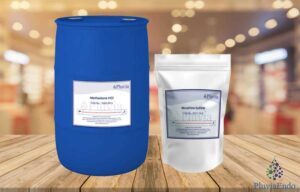Pain, an intricate and often debilitating phenomenon, has spurred the development of various analgesics over the years. Among these, Morphine Sulfate stands out as a potent opioid analgesic widely used for managing severe pain. In this comprehensive article, we embark on an exploration of Morphine Sulfate, unraveling its key characteristics, mechanisms of action, diverse applications, and the nuanced considerations that accompany its use.
Understanding Morphine Action
Morphine Sulfate, derived from the opium poppy plant, has a rich history dating back to ancient civilizations. Today, it remains a cornerstone in the realm of pain management, particularly in situations where other analgesics may prove insufficient. The drug operates by binding to specific receptors in the central nervous system, primarily the mu-opioid receptors, modulating the perception of pain.
Morphine’s molecular structure allows it to exert its effects by mimicking the body’s endorphins, neurotransmitters that naturally relieve pain. This affinity for opioid receptors makes Morphine Sulfate a powerful tool in the arsenal against severe pain.
Managing Severe Pain by Morphine Sulfate
The hallmark of Morphine Sulfate lies in its efficacy in managing severe pain. Whether it’s post-surgical recovery, cancer-related pain, or acute trauma, Morphine Sulfate plays a vital role in providing relief when milder analgesics fall short. Understanding the specific scenarios in which Morphine Sulfate is most beneficial and crucial for healthcare providers and patients alike.
Post-surgical pain often necessitates robust pain management to facilitate recovery. Morphine Sulfate’s ability to provide potent analgesia in the immediate postoperative period ensures that patients can comfortably navigate the critical early stages of healing. Moreover, in cancer care, where pain can be both chronic and severe, Morphine action effects significantly enhance the quality of life for patients facing the challenges of their condition.
Morphine Action, Analgesia, and Side Effects
As with any potent medication, achieving optimal pain relief with Morphine Sulfate requires a delicate balance. The article delves into the common side effects associated with Morphine Sulfate, such as nausea, constipation, and respiratory depression, providing insights into strategies for minimizing these effects while ensuring effective pain control.
Nausea, a common side effect of Morphine Sulfate, can often be managed with antiemetic medications, allowing patients to continue their pain management regimen without significant disruption. Additionally, constipation, another frequent concern, may necessitate proactive measures, such as increased fluid intake, dietary adjustments, and, if required, the use of laxatives to alleviate discomfort.
Morphine Sulfate Extended-Release Formulations
Extended-release formulations of Morphine Sulfate have been developed to provide sustained pain relief over an extended period. Examining the efficacy and considerations of these formulations offers healthcare providers and patients valuable information on optimizing pain management while reducing the frequency of medication administration.
Extended-release Morphine formulations are designed to maintain a steady concentration of the drug in the bloodstream, allowing for a more consistent and prolonged analgesic effect. This feature not only contributes to enhanced pain control but also offers potential benefits in terms of improved patient compliance and convenience.
Effects of Morphine Action on Opioid Tolerance
Long-term use of opioids, including Morphine Sulfate, can lead to the development of tolerance, requiring dose adjustments over time. The article explores strategies for managing opioid tolerance, emphasizing the importance of close monitoring, regular reassessment, and potential rotation to alternative opioids when necessary.
The phenomenon of tolerance involves the body adapting to the presence of the opioid, necessitating higher doses to achieve the same level of pain relief. Healthcare providers must be attuned to the potential development of tolerance and collaborate closely with patients to adjust doses as needed. This may involve exploring alternative opioid medications or considering adjuvant therapies to enhance overall pain management efficacy.
Safely Administering Morphine Sulfate in Young Patients
Pediatric pain management introduces unique challenges, and the article addresses the considerations involved in administering Morphine Sulfate to younger patients. Exploring appropriate dosages, potential side effects and the importance of individualized care ensures safe and effective pain relief for pediatric populations.
Pediatric patients present a distinctive set of considerations, including age-appropriate dosing and the potential impact of opioid therapy on developmental factors. The meticulous selection of doses, close monitoring for side effects, and involving parents or caregivers in the care plan are integral to ensuring the safety and efficacy of Morphine Sulfate in pediatric pain management.
Emerging Research on Morphine Action
Advancements in research continue to expand our understanding of Morphine Sulfate. The article delves into emerging studies exploring novel applications, potential combination therapies, and future directions in opioid pharmacotherapy. This section offers a glimpse into the evolving landscape of pain management.
Researchers are exploring innovative approaches to enhance the efficacy of Morphine Sulfate while mitigating potential side effects. This includes investigating combination therapies with non-opioid analgesics, such as anti-inflammatory medications, to create a synergistic effect that maximizes pain relief while minimizing opioid-related complications.
Morphine and Quality of Life in End-of-Life Situations
In palliative care, Morphine Sulfate plays a pivotal role in enhancing the quality of life for individuals facing terminal illnesses. The article discusses the compassionate use of Morphine Sulfate in this context, addressing pain management, alleviation of distressing symptoms, and the delicate balance between analgesia and patient comfort.
End-of-life care necessitates a holistic and compassionate approach to pain management. Morphine Sulfate, administered judiciously and with careful consideration of individual patient needs, becomes a crucial tool in providing comfort and dignity during the final stages of life. Palliative care teams must navigate the intricacies of pain relief while aligning with the broader goals of end-of-life care.
Concerns in Morphine Sulfate Therapy
The potential for addiction and dependency is an inherent concern with opioid medications. This section provides a nuanced exploration of the risk factors, signs of opioid misuse, and strategies for mitigating the risk of addiction while ensuring that patients receive the pain relief they need.
Addressing the potential for addiction involves a comprehensive approach that includes regular patient assessments, education on the safe use of opioids, and the incorporation of non-pharmacological pain management strategies when appropriate. Healthcare providers play a pivotal role in identifying individuals at risk and implementing tailored interventions to promote responsible opioid use.
Morphine Sulfate in Elderly Patients
Elderly patients often present distinct challenges in pain management, including altered pharmacokinetics and an increased susceptibility to side effects. The article examines the considerations and risks associated with administering Morphine Sulfate in the elderly population, emphasizing the importance of tailored approaches to ensure both safety and efficacy.
Older adults may experience age-related changes in drug metabolism and clearance, necessitating careful dosing adjustments to avoid adverse effects. Additionally, the potential for drug interactions and the presence of comorbidities further underscores the importance of personalized care plans for elderly patients requiring Morphine Sulfate for pain management.
Recognizing Symptoms and Emergency Response
While Morphine Sulfate is a crucial tool in pain management, the potential for overdose requires careful attention. This section provides insights into recognizing the symptoms of Morphine Sulfate overdose and outlines emergency response measures, underscoring the importance of education for healthcare providers and patients alike.
Overdose prevention involves vigilant monitoring of patients for signs of respiratory depression, sedation, and other indicators of opioid toxicity. Equipping healthcare providers and caregivers with the knowledge and tools to respond promptly to a potential overdose is critical in preventing adverse outcomes and ensuring patient safety.
Morphine Action for Effective Pain Relief
Morphine Sulfate stands as a cornerstone in pain management, offering potent analgesia for those experiencing severe pain. From its historical roots to its diverse applications in modern medicine, Morphine Sulfate requires a nuanced understanding for optimal use. By exploring its mechanisms, applications, and potential challenges, healthcare providers and patients can navigate the landscape of Morphine Sulfate with precision, ensuring that pain relief is achieved safely and effectively. Always consult with healthcare professionals for personalized advice and guidance regarding the use of Morphine Sulfate or any other medication, as individual circumstances may vary.
This comprehensive exploration aims to equip healthcare professionals, patients, and caregivers with the knowledge needed to make informed decisions about the use of Morphine Sulfate in pain management. The evolving landscape of opioid pharmacotherapy underscores the importance of staying informed about emerging research and novel approaches to optimize pain relief while minimizing potential risks.









